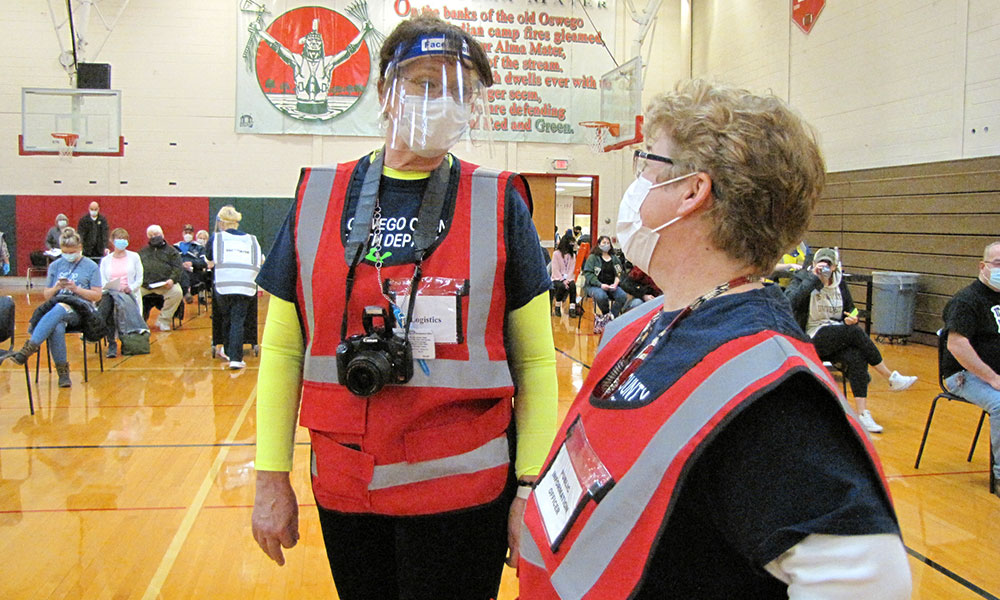And you can thank a Girl Scout for part of its success
By Tim Nekritz
nekritz@gmail.com
‘Health experts know getting out of the COVID-19 era will not be a piece of cake. The delta variant, some relaxation among society and a large unvaccinated population mean an ongoing challenge.’
Nobody likes to get a shot.
That said, what impressed me this year was how easy, efficient and — dare I say — fun the process of getting two COVID-19 vaccinations came via the Oswego County Health Department’s clinics.
And, in part, you can thank the Girl Scouts for that.
As I file this story, about half of county residents had received COVID-19 vaccinations (hopefully when you read this, it will be appreciably higher). Very many of those received their vaccines via a clinic conducted by the county.
I was one of those to go to a county clinic, in two installments at G. Ray Bodley High School. I got the Moderna vaccine — shout out to Dolly Parton!
Once you parked and came to the building, it was more pleasant than almost any other customer service experience from the past year.
Everybody was so friendly, so helpful and so knowledgeable that it almost took my mind out of getting a needle with a scientific marvel jammed into my arm.
From the person outside the door to the door greeters to the people who check you in to the people who organize any lines to the person who preps you to the person who gives you the shot to the person who schedules the next shot (if you receive a Moderna or Pfizer) to the people who check on you while you wait to a few minutes to ensure you don’t have a reaction — well, I felt like I made a bunch of new friends. They were warm, they were caring and they told you everything you needed to know.
But I know even that army doesn’t take into account the people who cleaned and sanitized and scheduled the shots and answered questions about registration who did all the little unseen jobs that made it run so smoothly.
So I wanted to reach out to Diane Oldenburg, the senior public health educator who I learned was a key player in organizing the clinics, to see why.
‘Amazing staff’
Oldenburg immediately credited two “amazing staff members” that she supervises, Sonia Robinson and Emily Boyle, emergency preparedness coordinators for the county.
“I think the background is important, since just after 9/11, local health departments have been given grant funds to prepare for public health threats, and we have trained to be able to stand up ‘points of distribution’ (PODs) for mass vaccination or distribution of antibiotics or other medical countermeasures,” Oldenburg explained. “We have trained in how to manage public health assets and distribute them — so things like medical supplies, equipment or medications.”
That’s where things got interesting with a little-known sweet fact about the role of Girl Scout cookies. For several years, the county’s health department conducted what Oldenburg called the “cookie drill,” a partnership with the Girl Scouts of NYPENN Pathways that allows them “to practice receiving, inventorying and distributing assets,” she said.
“In this drill, we use Girl Scout cookies to simulate these assets,” Oldenburg noted. “In these drills we move about 30,000 boxes of cookies. This drill pulls together health department staff from every department and many from other county departments: highway, buildings and grounds,sheriff’s, emergency management and promotions and tourism.”
Having nuclear plants in Oswego County requires another set of regular drills and emergency management knowledge as well, plus Oswego — like any county — is required to be prepared for crisis management.
“So we have a history in this county of getting support to respond to crisis — whether through our public health drills or the radiological drills and exercises coordinated by emergency management,” Oldenburg said. “The players are familiar to us and we are used to working together. Sonia and Emily coordinate our annual drills and exercises and develop a lot of the logistics and operations along with a team at the health department.”
Assembling a team
The mass vaccination efforts, like the ones I attended in Fulton, required “about 40 people, including parking assistants, flow control in the building, COVID-19 screeners at the door, registration, finance, medical screening, vaccinators, EMS (emergency medical services) and sheriff’s deputies,” Oldenburg said. “Many are county employees from the health department or other county agencies.”
They also reached out to volunteers and placed a call for signups on their website. In a county known for its volunteer spirit, it’s probably not surprising they received help from retired school nurses, volunteer firefighters and many other members of the community.
So, you get a lot of good people — but how do you make it run like a well-oiled machine?
“Before each clinic we do what we call a ‘just-in-time training,’ and run through the operations, and we have job action sheets available to explain the role,” Oldenburg said. “Those with more technical jobs like medical screening and our vaccinators, we usually partner them with an experienced person in the role until they feel comfortable to be on their own.”
COVID-19 is a stressor on many levels, and that includes receiving the vaccines, especially knowing about potential short-term side effects and making sure everything is handled in as safe an environment as possible. But the right attitude of those coordinating and working the clinics goes a long way in reassurance.
“We try to keep a relaxed atmosphere,” Oldenburg said. “I think being really organized and practiced lets the health department staff know that we can deal with the glitches as they come up.”
That the health department and other county partners support each other throughout the year means an air of familiarity and camaraderie that provides the right atmosphere.
“I think we know that the community will feed off the energy in the room and if we are calm, friendly and able to answer their questions and alleviate fears or apprehension that word spreads and people are more likely to share their positive experience with friends and family,” Oldenburg said.
(All the people sharing their vaccination photos and positive experiences on social media, me included, hopefully helped the cause.)
“Ultimately, we want to get as many folks vaccinated as we can to help protect the community and give residents a sense that some normalcy is around the corner,” Oldenburg noted. “Cupcakes help too! We have one volunteer that often brings homemade cupcakes for the staff.”
But health experts know getting out of the COVID-19 era will not be a piece of cake. The delta variant, some relaxation among society and a large unvaccinated population mean an ongoing challenge and a need to ensure the county’s team keeps welcoming visitors for their first vaccinations or for the booster shots they will expect to provide in the near future.
In the mean time, I suddenly feel a need to figure out where to get some Thin Mints.
 Tim Nekritz is director of news and media for SUNY Oswego, where he spearheads telling the stories of the campus community.
Tim Nekritz is director of news and media for SUNY Oswego, where he spearheads telling the stories of the campus community.




